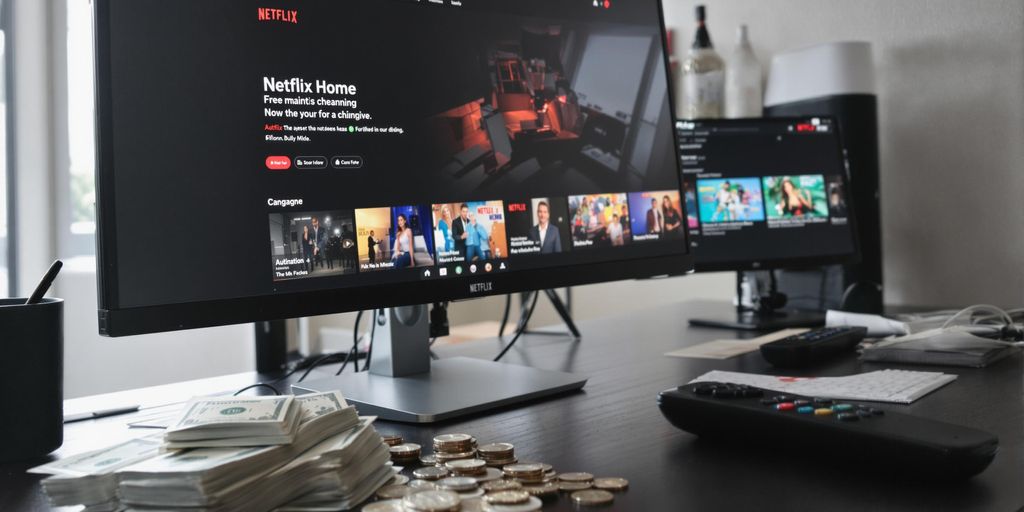Netflix, Inc. Revenue Analysis
Revenue Generation Through Subscriptions
Netflix primarily makes its money through subscription fees. People pay a monthly fee to access a wide range of TV shows, movies, and documentaries on their devices. This subscription model is the core of Netflix’s revenue strategy. The more subscribers they have, the more money they make. It’s pretty straightforward, really. They’ve also been experimenting with different subscription tiers, like a cheaper ad-supported option, to attract a wider audience.
Geographical Revenue Breakdown
Netflix breaks down its revenue by geographical region. This includes:
- United States and Canada (UCAN)
- Europe, Middle East, and Africa (EMEA)
- Latin America (LATAM)
- Asia-Pacific (APAC)
Understanding where Netflix’s revenue comes from helps them tailor their content and marketing strategies to different markets. For example, they might invest more in local content in a region where they’re trying to grow their subscriber base. In 2024, the revenue by segment was:
- United States and Canada (UCAN): $16.74 billion
- Europe, Middle East, and Africa (EMEA): $12.24 billion
Impact of New Revenue Streams
Netflix is also exploring new revenue streams beyond traditional subscriptions. The most notable is the introduction of an ad-supported tier. This allows users to pay a lower monthly fee in exchange for watching advertisements. While still a smaller portion of overall revenue compared to subscriptions, the ad-supported tier is growing and helps attract price-sensitive customers. It’s a way for Netflix to tap into a different segment of the market and unlock new opportunities.
Financial Performance Overview

Annual Revenue Growth
Okay, so let’s have a yarn about Netflix’s dosh. Their revenue growth has been pretty impressive, especially if you look back over the last few years. They’ve been pulling in more and more each year, which is what you want to see, right? But the rate of growth? Well, that’s been a bit up and down, and it’s something to keep an eye on. Here’s a quick look at how things have been tracking:
- 2022: Revenue was decent, but not amazing.
- 2023: A solid jump, showing they’re doing something right.
- 2024: Another good year, with revenue climbing again.
Net Income Trends
Net income is where things get interesting. It’s not just about how much money they’re bringing in, but how much they’re actually keeping after paying all the bills. Netflix has had its ups and downs here. Sometimes they’re swimming in cash, other times they’re just trying to keep their heads above water. A few things that impact this:
- Content costs: Making shows isn’t cheap, mate.
- Marketing spend: Gotta get those eyeballs on the screen.
- Expansion costs: Going global costs a pretty penny.
Key Financial Metrics
Right, let’s get down to the nitty-gritty. Here’s a table showing some of the important numbers. These metrics give you a good idea of how Netflix is performing overall. It’s all about understanding the story behind the numbers, you know?
| Metric | 2023 | 2024 | 2025 (Projected) |
|---|---|---|---|
| Revenue | $33.72 billion | $39 billion | $43.5 – $44.5 billion |
| Operating Profit | $6.95 billion | $10.42 billion | N/A |
| Operating Margin | 20.9% | 27.4% | 28% (Target) |
And here’s a look at cash flow:
| Cash Flow Item | 2024 | 2023 | 2022 | 2021 | 2020 |
|---|---|---|---|---|---|
| Operating Cash Flow | $7,360 | $7,270 | $2,030 | $392.61 | $2,430 |
| Investing Cash Flow | -$2,180 | $541.75 | -$2,080 | -$1,340 | -$505.35 |
| Financing Cash Flow | -$4,070 | -$5,950 | -$664.25 | -$1,150 | $1,240 |
Ad-Supported Revenue Model
Introduction of Ad-Supported Tier
Netflix’s introduction of an ad-supported tier was a pretty big deal, shaking things up a bit. It’s all about trying to grab those viewers who are a bit more price-conscious. This tier gives people a cheaper way to access Netflix, in exchange for watching a few ads. It’s still early days, but it looks like it’s doing alright so far, attracting a decent number of subscribers who might not have signed up otherwise.
Impact on Subscriber Growth
So, how’s the ad-supported tier actually affecting subscriber numbers? Well, it seems to be helping. It’s bringing in a new bunch of viewers who were put off by the standard prices. Plus, it gives existing subscribers a cheaper option if they’re willing to put up with ads. It’s a bit of a balancing act, though. Netflix needs to make sure the ads aren’t too annoying, otherwise people will just ditch the ad-supported tier and go back to the regular one. Here’s a quick look at how subscriber numbers have been tracking since the ad-supported tier launched:
| Quarter | Total Subscribers (Millions) | Change from Previous Quarter |
|---|---|---|
| Q1 2024 | 260.28 | 9.33 |
| Q2 2024 | 263.54 | 3.26 |
| Q3 2024 | 266.96 | 3.42 |
| Q4 2024 | 269.60 | 2.64 |
| Q1 2025 | 272.10 | 2.50 |
Future Projections for Ad Revenue
Looking ahead, ad revenue could become a much bigger part of Netflix’s overall income. It’s all about getting the balance right – making enough money from ads without annoying viewers too much. If they can pull that off, ad revenue could really boost their bottom line. Some analysts are predicting that ad revenue could account for a significant chunk of Netflix’s total revenue by 2025. Here are some possible scenarios:
- Base Case: Steady growth in ad revenue, contributing around 10% of total revenue by the end of 2025.
- Optimistic Case: Strong adoption of the ad-supported tier, with ad revenue reaching 15% of total revenue.
- Pessimistic Case: Slower adoption due to viewer resistance to ads, with ad revenue remaining below 5% of total revenue.
Technological Advancements in Streaming

Data Utilisation and Machine Learning
Netflix is pretty clever with data. They use it to figure out what we want to watch before we even know it ourselves! Their recommendation algorithm is a big deal, driving a huge chunk of content discovery. It’s all about predicting what you’ll like, optimising what they spend on content, and making sure you have a good time so you stick around. They even use it to work out their marketing. It’s pretty impressive, really. You can see how they use real-time data streaming to improve their service.
Video Encoding Innovations
They’re always trying to make the video quality better without using up all your data. Netflix has been pushing the boundaries with video encoding tech, coming up with new ways to compress video so it looks good even if your internet isn’t the best. This is super important as they expand into countries where the internet isn’t as fast as it is here. It means more people can watch without buffering all the time, which is a win for everyone.
User Experience Enhancements
Netflix is constantly tweaking how the app looks and feels. They want to make it as easy as possible to find something to watch and actually enjoy watching it. This includes:
- Making the interface simple to use on all devices.
- Personalising the experience based on what you’ve watched before.
- Reducing buffering times so you can get straight into the show.
They’re always testing new features and designs to see what works best. It’s all about making sure you have a good time, so you keep coming back for more. They are always improving their user interface design across devices.
Challenges Facing Netflix
Netflix is doing alright, but it’s not all smooth sailing, right? They’ve got some proper hurdles to jump over if they want to keep their spot on top. It’s a bit of a battlefield out there in streaming land.
Intense Competition in Streaming
The streaming wars are bonza, but they’re also a massive headache for Netflix. You’ve got Disney+, Stan, Amazon Prime Video, Paramount+, Apple TV+ – the list goes on! Everyone’s fighting for the same eyeballs, which means subscriber churn is a real worry. It’s getting harder and harder to stand out from the crowd, and that impacts how many new subscribers they can get, and how much they have to spend on content to keep people interested.
Password-Sharing Crackdown
Remember when everyone and their dog was using your Netflix account? Well, Netflix finally put the foot down. The password-sharing crackdown was meant to boost revenue, but it’s a bit of a double-edged sword. Some people probably signed up for their own accounts, but others might have just chucked Netflix altogether. It’s a gamble, and we’ll have to see if it pays off in the long run.
Content Production Costs
Making good telly doesn’t come cheap, mate. Netflix is splashing out serious cash on original content, and the costs just keep going up. They’re competing with everyone else for the best writers, actors, and directors, which drives up prices. Plus, they need to keep making new stuff to keep people hooked. It’s a constant balancing act between spending big and keeping the shareholders happy. They might need to adjust their content strategy to focus on fewer, higher-quality productions.
Future Growth Strategies
Netflix isn’t just sitting back and watching the world go by; they’re actively looking for ways to keep growing. It’s a tough market out there, so they need to be smart about it. Let’s have a look at some of the things they’re trying.
Exploring Live Events and Sports
For ages, Netflix has been all about on-demand stuff, you know, binge-watching whole seasons at once. But they’re starting to dip their toes into live events and even sports. Now, they’re probably not going to be bidding for the Premier League anytime soon – the costs would be insane. But they might look at smaller, niche sports or live events that could pull in viewers. This could be a good way to keep people hooked and offer something different from the usual streaming fare.
Bundling Services for Subscribers
Bundling is the new black, or so it seems. Netflix is looking at ways to bundle their service with other things to make it more attractive to subscribers. Think about it: Netflix with your mobile plan, or maybe with your internet. It’s all about making life easier and giving people more bang for their buck. For example, some mobile carriers offer free subscriptions with certain plans.
Partnerships and Collaborations
Netflix can’t do it all alone, so they’re teaming up with other companies. This could mean partnering with production companies to make more content, or even working with tech companies to improve the streaming experience. The ad-supported tier has opened up new avenues, and advertising revenue is expected to grow as more partnerships are forged. It’s all about finding ways to work together and share the load. Here’s a few things they could do:
- Partner with local telcos to offer bundled deals.
- Collaborate with gaming companies to integrate games into the platform.
- Work with social media platforms to promote content and engage with viewers.
User Engagement and Behaviour
Average Viewing Time
Okay, so how long are people actually watching Netflix? It’s a pretty important question, right? Well, on average, US adults are clocking in around 62 minutes a day. That’s a decent chunk of time! It shows Netflix is doing something right to keep people glued to their screens. It’s up from about 53 minutes back in 2019, so they’re definitely winning the battle for eyeballs. This increase in daily usage is a good sign, showing that Netflix is competing well for viewers’ attention.
Subscriber Retention Strategies
Keeping subscribers happy is the name of the game. It’s not just about getting new people in the door; it’s about making sure they stick around. Here’s what Netflix seems to be doing:
- Constantly updating content: They’re always adding new shows and movies to keep things fresh. No one wants to pay for the same old stuff, right?
- Personalised recommendations: Netflix’s algorithm is pretty good at suggesting stuff you might actually like. About 80% of users trust these suggestions. That’s a big deal!
- Improving the user experience: Making the app easy to use and enjoyable is key. No one wants to fight with a clunky interface.
Content Preferences and Trends
What are people actually watching? That’s the million-dollar question. Netflix is all about data, so they know what’s popular. Shows like Stranger Things, The Witcher, and Bridgerton are massive hits. Understanding these trends helps them decide what to invest in next. It’s all about giving the people what they want. They also need to consider cultural adaptation of content as they expand into new regions. For example, they might offer different language options or subtitles to cater to local audiences. This helps them attract and retain subscribers in those markets.
Here’s a quick look at some popular shows:
| Show Title | Genre |
|---|---|
| Stranger Things | Science Fiction |
| The Witcher | Fantasy |
| Bridgerton | Romance |
| Squid Game | Thriller |
| The Night Agent | Action |
Revenue Projections for 2025
Current Financial Guidance
Right, so Netflix has been chatting about their 2025 financial guidance, and it’s looking like they’re aiming for somewhere between US$43.5 billion and US$44.5 billion. That’s a fair chunk of change, but it’s worth having a proper look at what’s driving these numbers. They’re banking on getting more members, jacking up subscription prices a bit, and, crucially, making a lot more dosh from ads. It’s all about keeping the revenue stream flowing, innit?
Market Conditions Impacting Growth
Now, it’s not all sunshine and rainbows. The streaming game is chockers with competition these days. Everyone and their dog has a streaming service, so Netflix has to fight tooth and nail for every subscriber. Plus, they’ve been cracking down on password sharing, which might ruffle a few feathers, even if it does boost their numbers in the long run. And let’s not forget the cost of making all that content – it’s not cheap! They’re planning to invest about $18 billion in content in 2025, which is a fair whack more than the $16.2 billion they spent in 2024. All these things play a big part in whether they actually hit those revenue targets.
Long-Term Revenue Outlook
Looking ahead, Netflix is trying a few different things to keep the growth going. The ad-supported tier is a big one; apparently, it made up about 50% of new sign-ups in places where it’s available. They’re also dipping their toes into live sports, like NFL games and that Tyson-Paul boxing match. Who knows, maybe they’ll become the new home of sport? Plus, they’re always looking for partnerships and ways to bundle their services with other companies. If they can pull all that off, the long-term revenue outlook could be pretty good. Here’s a quick look at how things are shaping up:
| Metric | 2023 (Actual) | 2024 (Estimated) | 2025 (Projected) |
|---|---|---|---|
| Revenue (Billions) | $33.72 | $39 | $43.5 – $44.5 |
Content Strategy and Its Impact
Focus on High-Quality Productions
Netflix’s strategy hinges on making stuff that people actually want to watch. It’s not rocket science, right? But it means pouring a heap of money into original shows and movies. The goal is to create buzzworthy content that keeps subscribers hooked and attracts new ones. They’re not just throwing money at anything, though. They’re using data to figure out what people are into. It’s a bit of a gamble, but when it pays off, it really pays off. Think Squid Game or Stranger Things – massive hits that get everyone talking. This approach helps them stand out in a crowded market. Speaking of standing out, have you seen the latest releases?
Diversity in Content Offerings
It’s not just about having lots of content; it’s about having content for everyone. Netflix is trying to cater to different tastes and cultures. This means:
- Investing in international productions. Think shows from South Korea, Spain, Germany – the works.
- Making sure there’s a good mix of genres. From true crime documentaries to rom-coms, they’re trying to cover all bases.
- Promoting diverse voices and stories. This isn’t just about being politically correct; it’s about tapping into new audiences and perspectives.
This approach helps them grow their subscriber base globally. It also makes the platform more appealing to a wider range of people. It’s a smart move, really. They’re not just making shows for one type of person; they’re making shows for the whole world. It’s a big task, but they seem to be giving it a good crack. They are also using data analytics to understand what people want to watch.
Response to Viewer Preferences
Netflix isn’t just throwing stuff at the wall and hoping it sticks. They’re actually paying attention to what people are watching and how they’re reacting. This means:
- Using data to figure out what types of shows are popular.
- Looking at viewing patterns to see what people are watching when and for how long.
- Reading social media to see what people are saying about their shows.
They then use this information to make decisions about what to produce next. It’s a constant feedback loop. If a show is a hit, they might make more seasons. If a show is a flop, they might pull the plug. It’s all about giving people what they want. It’s a bit like being a mind reader, but with data. This helps them keep their subscribers happy and coming back for more. It’s a pretty clever system, if you ask me. They are also trying to maximise free trials to get more people hooked.
Global Market Presence
Netflix’s global strategy is pretty interesting, especially when you look at how they’re trying to get into new markets and deal with different cultures and rules. It’s not just about throwing content out there; it’s about making sure it actually works in each place.
Expansion into New Regions
Netflix is always looking for new places to grow. Think about it: India, Brazil, all those spots. Getting into these markets can really boost their subscriber numbers and, of course, their revenue. They’re not just setting up shop; they’re trying to become a big part of the local entertainment scene.
Cultural Adaptation of Content
It’s not enough to just translate shows. Netflix has to make content that actually resonates with people in different countries. That means understanding what people like, what their values are, and what kind of stories they connect with. It’s a big job, but it’s super important for getting people to subscribe and stick around. They are doing this by:
- Investing in local productions.
- Partnering with local creators.
- Analysing viewing data to understand preferences.
Regulatory Challenges in Different Markets
Every country has its own set of rules, and Netflix has to play by them. This can mean dealing with things like content quotas, taxes, and censorship. It’s a constant balancing act to stay on the right side of the law while still giving people the content they want. It’s a bit of a headache, but it’s just part of doing business on a global scale.
Competitive Landscape Analysis
Key Competitors in the Market
The streaming world is a proper battleground, isn’t it? Netflix isn’t the only player anymore; there’s a stack of companies all vying for our attention and, more importantly, our subscription money. You’ve got the big guns like Amazon Prime Video and Disney+, not to mention relative newcomers like Paramount+ and Stan (here in Oz). And let’s not forget the free-to-air catch-up services that are also competing for viewing hours. It’s a crowded market, and everyone’s trying to stand out.
Market Share Trends
Keeping track of who’s winning the streaming wars is a bit like watching the footy scores – it changes all the time. Netflix was the undisputed champ for ages, but its market share has been slowly eroding as more competitors enter the fray. Disney+, in particular, has made a big splash, thanks to its massive library of Marvel, Star Wars, and Disney classics. Amazon’s Prime Video is also a serious contender, especially with its growing investment in original content and its integration with Amazon Prime memberships. It’s a constant tug-of-war, and market share trends are something everyone’s keeping a close eye on.
Differentiation Strategies
So, how do these streaming services try to get ahead? Well, it’s all about offering something unique. Netflix is still pushing hard on original series and films, trying to create those must-watch shows that everyone’s talking about. Disney+ is banking on its existing franchises and family-friendly content. Amazon’s bundling Prime Video with its other services, making it a pretty attractive deal for many. Some services are focusing on niche genres or international content to appeal to specific audiences. And then there’s the ad-supported tier, which is another way to attract price-sensitive customers. Ultimately, it’s about finding a way to stand out from the crowd and give viewers a reason to choose one service over another. A BCG Matrix can help analyse these strategies.
Final Thoughts on Netflix’s Revenue Landscape
In wrapping things up, Netflix’s journey through the streaming world is a mixed bag of triumphs and hurdles. Sure, they’ve seen impressive revenue growth, hitting $39 billion in 2024, but the road ahead isn’t all smooth sailing. Competition is fierce, and they’re facing challenges like password sharing and rising content costs. Still, Netflix is trying to adapt, looking into new ways to boost revenue, like their ad-supported tier and exploring live events. It’s a balancing act, really. They need to keep their subscriber base happy while also finding fresh ways to make money. So, while Netflix is doing well now, the future will depend on how they tackle these challenges and seize new opportunities.
Frequently Asked Questions
How does Netflix make money?
Netflix earns money mainly through subscription fees. People pay to watch movies, TV shows, and documentaries on their devices.
What are the main regions where Netflix generates revenue?
Netflix makes money from different parts of the world, including the United States, Europe, Latin America, and Asia.
What is the ad-supported subscription plan?
The ad-supported plan lets users pay a lower fee to watch Netflix but includes ads during shows and movies.
How has Netflix’s revenue changed recently?
In 2024, Netflix’s revenue grew to $39 billion, which is a 16% increase compared to the previous year.
What challenges is Netflix currently facing?
Netflix is dealing with tough competition from other streaming services, high costs for making new shows, and issues with password sharing.
What strategies is Netflix using for future growth?
Netflix is looking into new ideas like live sports, bundling services, and partnerships to attract more subscribers.
How does Netflix keep viewers engaged?
Netflix focuses on creating popular shows and movies, which helps keep viewers watching and subscribing.
What are the revenue predictions for Netflix in 2025?
Analysts expect Netflix to earn between $43.5 billion and $44.5 billion in revenue by 2025.




